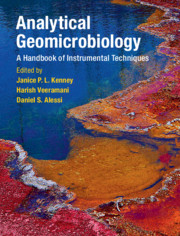Book contents
- Analytical Geomicrobiology A Handbook of Instrumental Techniques
- Analytical Geomicrobiology
- Copyright page
- Contents
- Contributors
- Foreword
- Part I Standard Techniques in Geomicrobiology
- Part II Advanced Analytical Instrumentation
- Part III Imaging Techniques
- Part IV Spectroscopy
- 9 X-ray Diffraction Techniques
- 10 Application of Synchrotron X-ray Absorption Spectroscopy and Microscopy Techniques to the Study of Biogeochemical Processes
- 11 Bacterial Surfaces in Geochemistry – How Can X-ray Photoelectron Spectroscopy Help?
- 12 Applications of Fourier-transform Infrared Spectroscopy in Geomicrobiology
- 13 Mössbauer Spectroscopy
- Part V Microbiological Techniques
- Index
- References
12 - Applications of Fourier-transform Infrared Spectroscopy in Geomicrobiology
from Part IV - Spectroscopy
Published online by Cambridge University Press: 06 July 2019
- Analytical Geomicrobiology A Handbook of Instrumental Techniques
- Analytical Geomicrobiology
- Copyright page
- Contents
- Contributors
- Foreword
- Part I Standard Techniques in Geomicrobiology
- Part II Advanced Analytical Instrumentation
- Part III Imaging Techniques
- Part IV Spectroscopy
- 9 X-ray Diffraction Techniques
- 10 Application of Synchrotron X-ray Absorption Spectroscopy and Microscopy Techniques to the Study of Biogeochemical Processes
- 11 Bacterial Surfaces in Geochemistry – How Can X-ray Photoelectron Spectroscopy Help?
- 12 Applications of Fourier-transform Infrared Spectroscopy in Geomicrobiology
- 13 Mössbauer Spectroscopy
- Part V Microbiological Techniques
- Index
- References
Summary
Fourier-transform infrared (FTIR) spectroscopy is a technique that measures the molecular-level vibrations in a material, such as a bacterial biofilm, to get a better understanding of the chemistry of the system. This technique is best used to observe changes in a system, e.g., how bacteria protonate and deprotonate as a function of pH or how contaminants sorb to minerals/bacteria, or for tracking the precipitation of a mineral or the breakdown of a contaminant in a system. It can also be used to identify the presence of a specific contaminant in a system, e.g., the presence of bacteria on an antimicrobial surface or the presence of pesticides in water. Thewill outline the different ways in which FTIR spectroscopy may be used to analyze a variety of samples in geomicrobiology. The techniques and their applicability are detailed, from individual sample recording (via diffuse reflectance measurements) to continuous monitoring of systems (using attenuated total reflectance measurements) and spatially resolved microspectroscopic analysis (either as imaging or as determining the positions for point sampling in a heterogeneous sample), and a general strategy for data handling is given, including the basics of some multivariate techniques. We will explain how to get the best possible data using each FTIR spectroscopic method, as well as how to best treat your data before analysis. Additionally, this chapter deals with understanding how to identify the representative FTIR bands for bacteria, and how those bands can change as a function of pH.
- Type
- Chapter
- Information
- Analytical GeomicrobiologyA Handbook of Instrumental Techniques, pp. 288 - 313Publisher: Cambridge University PressPrint publication year: 2019
References
12.8 References
- 4
- Cited by



